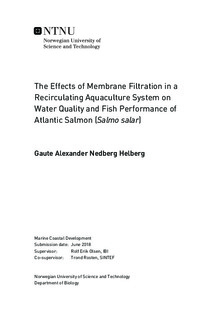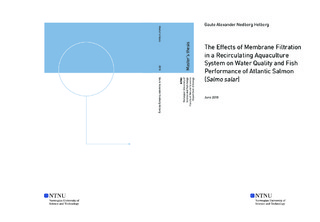| dc.description.abstract | Recirculating aquaculture systems (RAS) could be a solution to several of the challenges associated with environmentally sustainable growth of the aquaculture industry. However, high investment and operating costs are associated with RAS, and intensification through reduction of water usage and increasing biomass densities might be necessary to increase economic feasibility. Furthermore, intensification is linked with risks of accumulation of compounds such as small particles not removed by traditional water treatment, which reduce the quality of the water, and may affect the performance and quality of the fish. There is currently limited knowledge on how particles affect fish performance in RAS, and how different removal efficiencies of small particles may affect water quality development. Membrane filtration could be used to remove small particles and bacteria, although the effects on production of Atlantic salmon (Salmo salar) is not thoroughly studied.
The aim of this thesis was to investigate how utilisation of a membrane filter for particle removal in RAS affects water quality development and fish performance of Atlantic salmon. Two pilot-scale RAS were compared; one system using conventional water treatment components (cRAS), and one including a membrane filtering 10% of the circulated water (mRAS). Water quality parameters (temperature, oxygen, salinity, carbon dioxide, pH, alkalinity, total ammonia nitrogen, nitrite, nitrate, turbidity and total suspended solids) and fish performance parameters (weight, length, morphological welfare indicators, blood values, smoltification indicators and recovery from handling stress) were measured at selected time points over the course of 18 weeks, and results from cRAS and mRAS were compared. Unforeseen circumstances forced changes in operational conditions during the experiment, dividing the study into distinct periods; two with low particulate load, and two with high particulate load. The observed differences in water quality caused by membrane filtration, was primarily lower turbidity due to increased removal of particles, and increased water temperature due to the production of heat caused by operating the membrane. Dissolved oxygen and carbon dioxide levels were also different, which could be coupled to the diverging biomasses in the systems. Higher growth occurred in mRAS, likely the result of a higher water temperature. The biggest discrepancy in fish performance was growth, making it difficult to conclude whether membrane filtration would be beneficial from a fish performance perspective had the temperature been controlled. If the effect on temperature is taken into account and utilised, membrane filtration could prove to be a good addition in a RAS for particle removal purposes. | |

